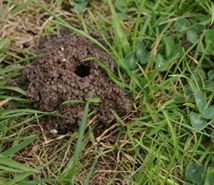
Create a Backyard Pollinator Habitat
- Information for Gardeners in the USA and Canada
Updated July 2022
Welcome! I've written this page specially to give visitors to my website from the USA and Canada some ideas where to get further information about creating a backyard pollinator habitat. It doesn't matter what size your garden is - Even small city yards can make a difference.
Your soils, climate and native wildlife are significantly different to those here in Western Europe, so information on wildlife gardening intended for British and Irish gardeners will not always be relevant to your conditions.
The general principles of garden management listed on my Gardening for Nature page do apply to you. Plenty of plant ‘structure’ to give your garden a variety of mico-habitats, leaving some dead stems and seedheads over winter, and not using pesticides - all this applies to you too.
However, when choosing plants that are suitable for your region and appropriate for your local wildlife you need to seek local advice. Many of the plants recommended for wildlife gardens in Britain and Ireland are not suitable for North America.
For example, several well-behaved European wild flowers that are often recommended in the UK as bee and butterfly plants are highly invasive in North America. On the other hand, there are many scarlet, trumpet- shaped flowers that are of little or no use to wildlife here in Europe, but are grown in North American gardens as they will attract hummingbirds. (We don’t have hummingbirds in Europe).
You have some really good information resources intended specifically for gardeners in the USA and Canada, and I list many of these below.
THE NEXT POLLINATOR WEEK WILL BE JUNE 19th - 25th 2023
Where to get information
For further reading I recommend:
Stein, Sara Bonnett:
Noah's Garden: Restoring the Ecology of our own Backyards.
ISBN: 0395653738 (out of print, but readily available from book dealers such as abebooks.com)
Marinelli, Janet: Stalking the Wild Amaranth: Gardening in the Age of Extinction.
Henry Holt, 1998. 238pp. ISBN: 0 8050 4415 9
Grissell, E: Insects and Gardens. Timber Press, 2001. ISBN 088192 504 7
(One of my favourite books - should be compulsory reading for every gardener).
Buchmann, S, and Nabhan G P: The Forgotten Pollinators. Shearwater Books, 1997. ISBN 155963 353 0. (A "good read" - not at all dry or boring - another of my favourite books).
Holm, Heather: Pollinators of Native Plants. Attract, Observe and Identify Pollinators and Beneficial Insects with Native Plants. Pollination Press, 2014. 306pp. ISBN 978-09913563-0-0. I highly recommend this book - it has lots of useful information about insects, flowers and their geographical distribution.
Butterfly Gardening: Creating Summer Magic in Your Garden
Sierra Club Books, 1998. 208pp. ISBN 0 87156 975 2. Sponsored by the Xerces Society and the Smithsonian Institution.
Pollinator Conservation Handbook. A guide to understanding, protecting, and providing habitat for native pollinator insects. Xerces Society, Portland OR. 2003. ISBN 09744475 01
The list above, which is specially for gardeners in the USA and Canada, is by no means exhaustive, but gives you some very good places to start. There are longer reviews of some of these books in Chapter 11 of my Bibliography, which you can download as a pdf from my Recommended Reading page
Here are some links to websites for gardeners in the USA, and some for Canada:
Checked and updated July 2022
Gardens and Wildlife
USA National Wildlife Federation : Garden for Wildlife
Wildlife gardening pages of the Canadian Wildlife Federation: Wild About Gardening
Pollinators
Xerces Society
A leading organisation concerned with the protection of invertebrates and their habitats. This site has useful and topical information about all kinds of pollinators.
Million Pollinator Garden Challenge
A campaign in the USA to register a million public and private gardens and landscapes to support pollinators, in collaboration with the National Pollinator Garden Network.
Pollinator Partnership (USA):
Has links to 36 pollinator-friendly planting guides for each region of the USA, and details of the annual National Pollinator Week (in June) and other resources.
Pollinator Partnership Canada (P2C):
Has links to pollinator-friendly planting guides for each region of Canada, and details of the annual National Pollinator Week (in June) and other resources.
Seek is a phone app which will identify flowers and insects. You can use it to submit sightings to iNaturalist, an online recording portal.
Butterflies and Moths of North America
Butterflies in Your Playground
This website belongs to a commercial playground equipment company but has a lot of useful links for schools
US Forest Service: Pollinators
UC Berkeley Urban Bee Lab:
A site from University of California at Berkeley with lots of info about planting your garden to encourage wild bees.
University of California, Davis: The Bee Haven
The UC Davis Bee Haven is a unique outdoor museum where visitors can observe and learn about bees and the plants that support them. This websites includes links to a blog and other information about planting for pollinators in an arid south western climate.
Migratory Pollinators Program:
An attractive, slightly more scientific site from the Arizona-Sonora Museum explaining the ecological role of pollinator species that migrate with the seasons.
Native Buzz:
Solitary Bees and wasps in your own back yard. A page from the University of Florida with useful info about managing bee blocks.
Resonating Bodies
"Resonating Bodies” is a series of integrated media installations, community outreach projects and educational initiatives which focus on biodiversity of pollinators indigenous to natural and urban ecosystems of Canada and beyond.
Enjoy your gardening, and thanks for visiting my website
Last updated July 2022 © Marc Carlton 2006 - 2022. Terms of Use.


